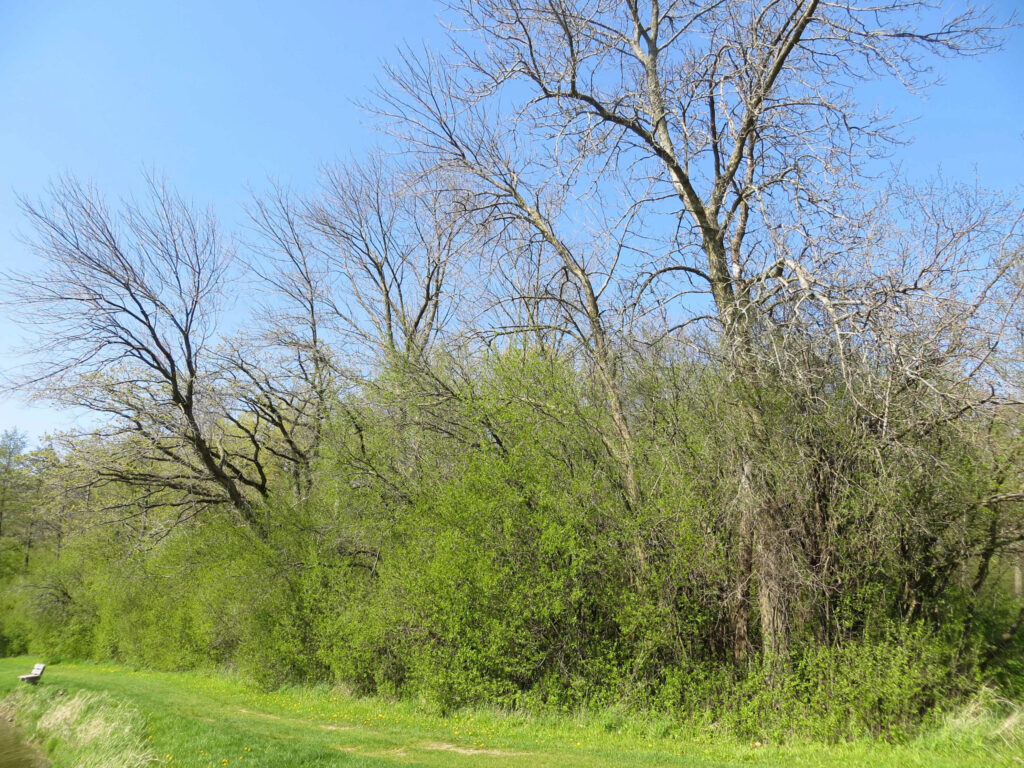By Dan Buckler, DNR Urban Forest Assessment Specialist, Madison, daniel.buckler@wisconsin.gov or 608-445-4578
How extensive are buckthorn and other invasive species in our communities? We don’t know yet, but Wisconsin’s Urban Forest Inventory And Analysis (UFIA) project will be able to answer that and many other questions.

Buckthorn beneath dead ash trees at Big Foot Beach State Park. Photo by Bill McNee.
Besides simple stem counts, we can learn about the type of land where buckthorn is found, species under which buckthorn is growing and trends in invasive species expansion or decline over time.
The Morton Arboretum undertook a similar study to Wisconsin’s Urban Forest Inventory And Analysis project for Chicago and the seven-county region around it. This report summarizes results from both 2010 and 2020. Those results were alarming; a whopping 45% of tallied trees were considered invasive in the region, with European buckthorn accounting for 36% of all trees. In the City of Chicago, the leading species were white mulberry at 14%, with combined buckthorn species at 10%.
Of course, buckthorn and other common invasive species are relatively small, and stem count (abundance) might not be the appropriate metric to gauge how dominant they are on a landscape. Instead, managers and analysts also incorporate leaf area to calculate a species’ importance value (IV). The importance value adds the species’ abundance to the species’ gross leaf area.
Bigger, though less abundant, trees could have high importance values. For example, black walnut in the seven-county area represents 2% of all trees for an importance value of 9% but 7% of leaf area. In this context, it’s even more astounding that European buckthorn is so plentiful that it also has the greatest leaf area (10% of all leaf cover) across the region, with a distressing importance value of 46%. Chicago’s importance values are less distressingly led by silver (19%) and Norway (14%) maples.
While this author does not anticipate such dire results for Wisconsin communities, none of us staring into a buckthorn understory or ash canopy is ignorant of the challenges facing our urban forests.
Despite some truly incredible parks, forests and savannas in Chicagoland and heroic work by thousands of nature lovers, buckthorn and other invasive species pose existential threats to those lands and the hours contributed by those people. Much more work is needed.
That is why Urban Forest Inventory And Analysis is so important. The project, which includes the establishment of 1,300 plots across Wisconsin urban areas, tracks the status and trends in urban forest canopy, extent, diversity, growth, mortality, habitat and overall health. Because we monitor and assess our urban forests, we can better approach the myriad difficulties at hand with clear eyes.
Data from the Madison and Milwaukee metro areas will be available in late 2022, with statewide urban areas coming in 2023. If there is anything you are particularly interested in learning about our urban forests, contact Dan Buckler at daniel.buckler@wisconsin.gov.
